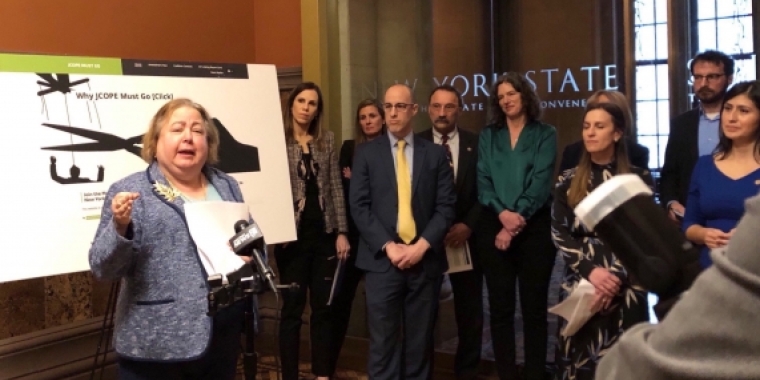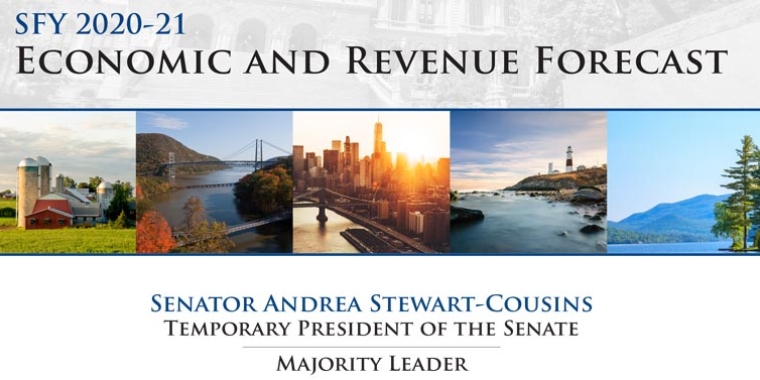
Senators Urge Governor Cuomo To Push For Stronger RGGI Emissions Cap
December 1, 2016
-
ISSUE:
- RGGI
- Climate Change
New York – Today, State Senators Liz Krueger, Brad Hoylman, and Tony Avella, along with thirteen other Senators, released a letter to Governor Andrew M. Cuomo, urging him to push the Regional Greenhouse Gas Initiative (RGGI) Board of Directors to implement the strongest possible cap reduction rate for the period 2020-2030. Included with the letter were comments submitted by the Senators directly to the RGGI board as part of the 2016 RGGI Program Review. The letter and comments are reprinted below and can also be viewed here and here.
"RGGI has been a valuable tool in New York's efforts to fight climate change, demonstrating that states can come together and use market-based mechanisms to drive down emissions," said Senator Krueger. "The last few years have seen significant climate action -- nationally, internationally, and here in New York. In the aftermath of the presidential election, it is clearer than ever that further progress is going to be driven by states and localities. New York must remain at the forefront of those efforts, and I urge Governor Cuomo to continue to take bold steps to protect New Yorkers from the climate crisis."
"RGGI is our state's most effective tool to fight human-induced climate change," said Senator Hoylman, Ranking Member of the Environmental Conservation Committee. "As we confront the dangerous consequences posed by President-Elect Trump and his administration of climate deniers, it's more important than ever for states like New York to take the lead with aggressive climate goals. A 5% annual carbon emissions reduction is an easily-achievable target that the RGGI Board of Directors must include if the RGGI states are going to continue to lead on climate."
During 2016, the RGGI member states (Connecticut, Delaware, Maine, Maryland, Massachusetts, New Hampshire, New York, Rhode Island, Vermont) are engaged in a Program Review, which will determine the level of the program's carbon emissions cap between 2020 and 2030. Since RGGI's inception in 2009, actual emissions reductions have averaged 3.8 million tons per year, below the currently mandated cap reduction averaging 2.1 million tons per year. Continuing the current 2.5% cap reduction rate through 2030 would lead to mandated reductions of only 1.95 million tons per year, roughly half the current rate of actual reductions. A 5% cap reduction rate, which is being pushed by leading environmental organizations, would lead to mandated reductions of 3.9 million tons per year, on par with historical reductions.
According to a March, 2016 report from Synapse Energy Economics, a 2030 RGGI cap of 39 million tons provides the least-cost pathway to achieving member states’ economy-wide 2030 emissions targets. A 39 million ton cap by 2030 is the same level proposed under the 5% annual cap reduction scenario. The Synapse report also demonstrates that such a cap would lead to energy ratepayer savings of $25.7 billion and the creation of an average of 58,400 new jobs per year across member states.
“It is imperative that we demonstrate a strong commitment to reducing greenhouse gasses,” Senator Toby Stavisky said. “We have reached a point where the bare minimum can no longer be acceptable, which is why my colleagues and I are calling for scenarios that will result in a 5 percent annual decline in the emissions cap. Such a percentage can result in reductions of 3.9 million tons per year. The bleak realities of climate changes can no longer be ignored.”
“Any real hope of reducing carbon emissions and reversing its effects in New York is dependent upon our resolve to remain committed to doing so," said Senator Martin Malavé Dilan. "The Regional Greenhouse Gas Initiative was a first in this country. It was bold and its members knew what we were looking to do and what was needed to do it. RGGI set a new standard and its member states have seen the positive results. But those results have only come about by remaining committed to those goals. If we are to go off course today, and set our emission caps both below what got us today’s results and what we need to meet our end goal, we’ve wasted seven years of progress and condemned the next 14 to the same negligence that brought about this climate pact in the first place.”
###
November 30, 2016
Andrew M. Cuomo
Governor
The Capital
Albany, NY 12224
Dear Governor Cuomo,
Please see the attached comments on the 2016 RGGI Program Review, which we submitted today to the RGGI Board of Directors. In order for RGGI to continue contributing to a comprehensive approach to reducing GHG emissions that prevents the worst effects of the climate crisis, it is imperative that the strongest possible cap reduction rate be implemented for the 2020-2030 period.
A 5% annual cap reduction rate is the absolute minimum required to ensure RGGI remains an effective tool through 2030. We urge you to build on your climate leadership and prevent backsliding in regional efforts to achieve bold emissions reduction targets by strongly advocating for a 5% rate.
Thank you for your consideration, and for your efforts to fight climate change and protect New Yorkers - today and for generations to come.
Sincerely,
Liz Krueger
Brad Hoylman
Tony Avella
Neil D. Breslin
Martin Malavé Dilan
George Latimer
Velmanette Montgomery
Kevin S. Parker
Jose Peralta
Bill Perkins
Roxanne J. Persaud
Gustavo Rivera
James Sanders, Jr.
José M. Serrano
Daniel L. Squadron
Toby Ann Stavisky
Stakeholder Comments on the 2016 RGGI Program Review
November 30, 2016
As elected legislators representing the interests of the people of the State of New York, we appreciate the opportunity to submit comments regarding the 2016 RGGI Program Review. Climate change is the single greatest threat facing our state, our nation, and our planet, and RGGI is and must continue to be a vital part of a comprehensive approach to reducing GHG emissions and avoiding the worst effects of the climate crisis.
We were dismayed that the Stakeholder Meeting held on November 21, 2016, did not include modeling scenarios for a 5% annual decline in the emissions cap. During this review process it is essential that no feasible emissions reduction scenario be taken off the table. By any reasonable analysis, a 5% cap decline is not only feasible, but is a conservative goal relative to actual emissions reductions achieved under the current cap. We urge you to continue modeling and consideration of the 5% scenario as the minimum acceptable rate of decline to efficiently and cost-effectively achieve the 2030 and 2050 emissions reduction goals of the RGGI member states.
Since RGGI’s inception in 2009, member states have seen a reduction of emissions well below that mandated under the current cap. Actual emissions reductions have averaged 3.8 million tons per year (with electricity rates falling an average of 2%), compared to a RGGI cap averaging 2.1 million tons per year through 2020. A 2.5% cap reduction scenario for 2020-2030 would result in mandated reductions of only 1.95 million tons per year, half the current rate, and potentially too low to reach states’ climate targets. A 5% scenario would lead to mandated reductions of 3.9 million tons per year, on par with historical reductions, though still less of a reduction than current trends project through 2030.
According to the March, 2016 report from Synapse Energy Economics, a 2030 RGGI cap of 39 million tons provides the least-cost pathway to achieving states’ economy-wide 2030 emissions targets. A 39 million ton cap by 2030 is the same level proposed under the 5% scenario. The Synapse report also demonstrates that such a cap would lead to energy ratepayer savings of $25.7 billion and the creation of an average of 58,400 new jobs per year across member states.
Now is not a time for half-measures or taking backward steps, which is exactly what a 2.5% cap reduction rate represents. The realities of climate change mean that bold action is not only the prudent course, but it is the minimum required to avoid catastrophic effects. Those effects will be felt by all of us, our children and grandchildren, and particularly our most vulnerable citizens. We request that you keep them in mind as you continue the review process, and we strongly urge you to consider at least a 5% annual cap reduction rate for 2020-2030.
Share this Article or Press Release
Newsroom
Go to NewsroomSenator Krueger's Community Bulletin - March 2020
March 9, 2020

SFY 2020-21 Economic and Revenue Forecast
February 27, 2020

Information On The Coronavirus
February 27, 2020

